Before I get into the body of this article’s discussion, a little background is first required. I originally offered to write this piece in response to a recent request concerning Critical Race Theory (CRT) from the editor of the US Skeptic magazine, Michael Shermer:
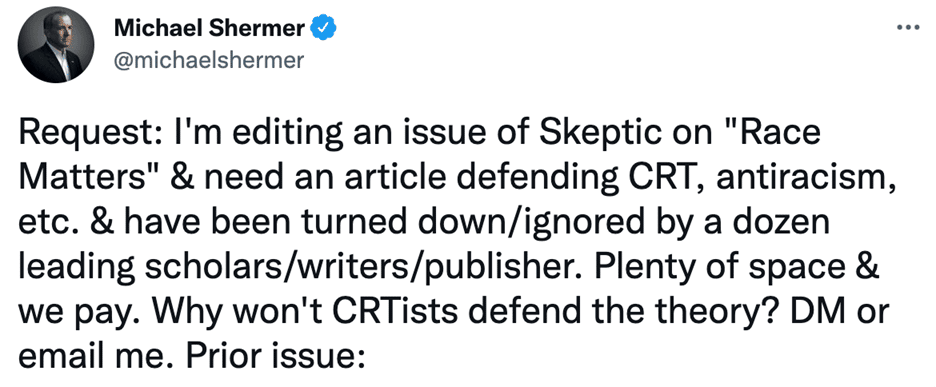
CRT, and what I believe is the moral panic surrounding it, is something I’ve written about in the past, so I reached out to Mr. Shermer, who told me he already had a CRT overview article “that mostly summarizes the history of the movement going back to its postmodernism roots (and before)”, which he described as “mostly neutral, albeit slightly critical on the consequences of accepting fully the belief in system racism by POC.” I later found out that that “article” is actually the CRT chapter from James Lindsay and Helen Pluckrose’s book Cynical Theories, two individuals who played a significant role in developing and mainstreaming the CRT moral panic.
Shermer explained that he and his editor liked my Arc Digi piece on the moral panic aspect of the CRT conversation, and asked me to write a:
relatively short (1500-2000 words) point-by-point analysis of the problem of extremism over CRT, most notably by the Right by people like Chris Rufo (the screen shots of his tweets are perfect so use those), the problem of turning it into a moral panic, etc.
He also suggested I criticise pro-CRT extremism, citing Scientific America’s article on how the treatment of minority STEM students likely contributes to an ongoing lack of diversity, because
the only hypothesis they entertain… is that mathematicians (and by extension most STEM professors) are racists (and mysognynists).
It’s important to note that this initial request did not simply ask for a bulletpoint debunking or a pure focus on ideas, it was a request for one explanation of the political and social aspects of the panic. Finally, he explained they were up against a deadline and asked if I could have something for him within two days, which I agreed to do.
After considering the prompt some, I felt that a focus on “extremism on both sides” would not accurately explain “the problem of turning it into a moral panic”, which I explained in an email exchange:
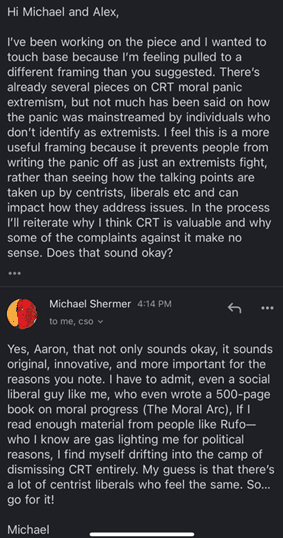
I considered this a rousing endorsement for my approach, and was inspired by Shermer’s self-assessment to use his position as an illustration in the article, while making clear the criticisms apply to many individuals. I sent through a first draft of the piece, which resulted in a back and forth where Shermer asked for more examples in a way that I believe would have compromised the piece, by asking me to focus on Rufo and not discuss Shermer or Lindsay:
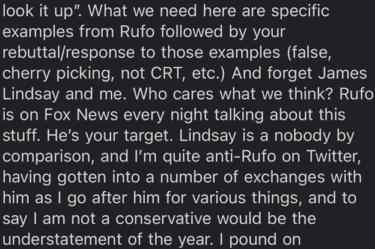
I responded that I was happy to add more examples, but I wasn’t willing to cut out the other material that I thought was essential to understanding how moral panics spread:
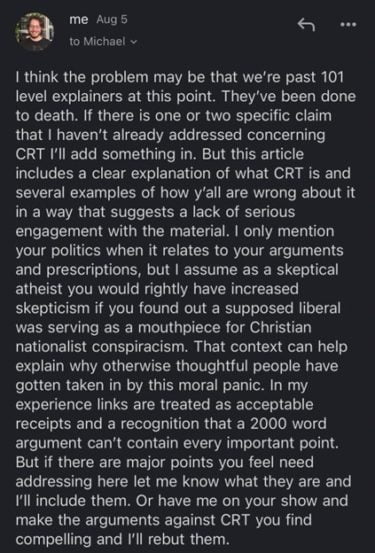
After additional back and forth, where Shermer provided examples of the sorts of things he wanted debunked and I agreed to work in material to address his requests, I received the following:
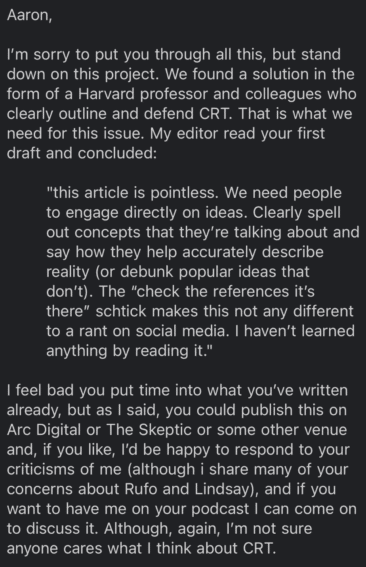
I find the radical shift from “original, innovative, and more important” to “pointless”
disappointing, especially when I was originally asked to discuss more than just the “ideas”. I also think the demand to focus on ideas and not people comes from an information deficit debunking model that I think is out of date. Readers of Skeptic Magazine in the US have ample access to CRT explainers; what I thought they would benefit from was a way to understand why self-identifying skeptics seem caught up in a moral panic, and how to avoid that fate.
I think there’s a problem of credulous “centrist” analysis that makes everything about competing extremes, so they can feel like they’re not contributing to the problem. I would have much preferred this piece get published in Skeptic Magazine, as I believe Shermer’s readership could benefit from considering this sort of pushback. Thankfully, The Skeptic has welcomed the piece, so that readers here can decide if it’s pointless or not.
Explaining the Critical Race Moral Panic
The current CRT moral panic began in the summer of 2020, when the conservative activist Chris Rufo drew on work by James Lindsay and other self-identifying liberals to convince president Donald Trump to pass an executive order banning the use of “divisive concepts” in federal employee training. The executive order never referenced CRT, but it banned the discussion of divisive ideas commonly associated with CRT, as well as topics like “inherent sex differences”. I and many others have repeatedly cited the tweets where Rufo openly declares he’s onboard with Lindsay’s plan, which he appears to describe as conflating CRT with “the entire range of cultural constructs that are unpopular with Americans”:
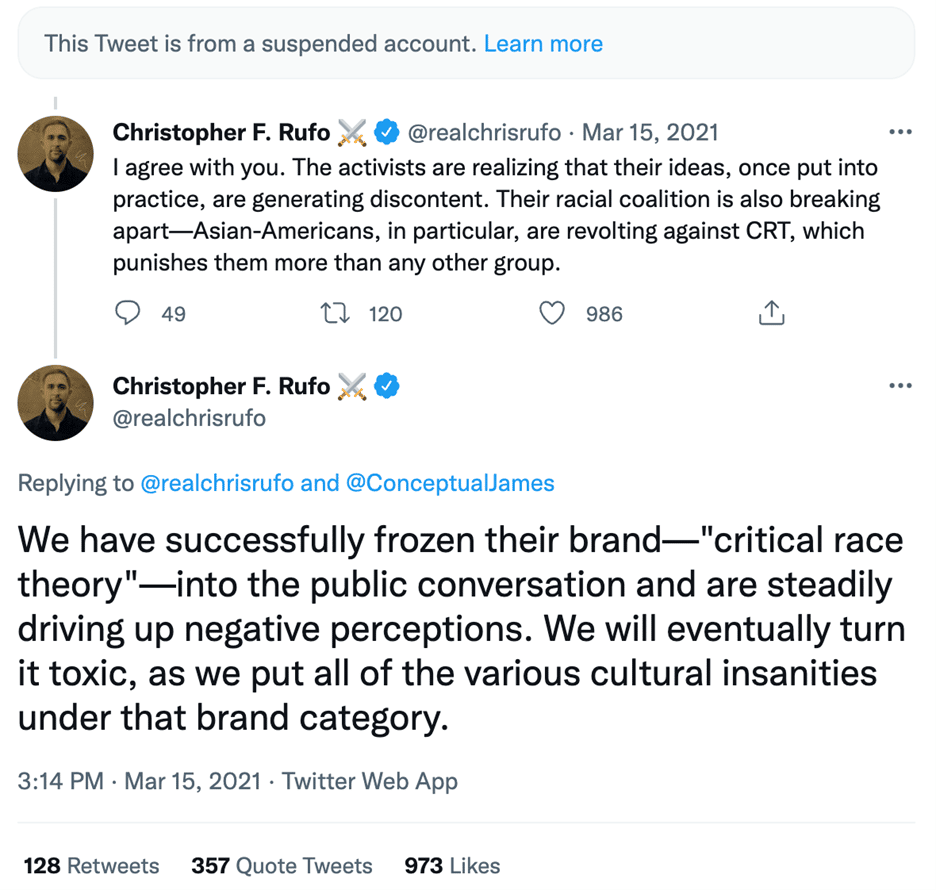

To me, and many others who have criticised Rufo, this amounts to a fancy way of saying “we’re doing an ‘everything goes’ moral panic to scare the shit out of Americans by telling them CRT is all the un-American things put together”. The result was a hugely successful moral panic that garnered credulous support from individuals like Shermer who self-identify as skeptical, moderate, and liberal, while quickly expanding to include attacks on all things progressive – including accusing pro-LGBTQ teachers of sexually grooming children.
Rufo and Lindsay have received ample attention for their fear mongering – criticism that the “Post-tribal” media ecosystem that credulously gave their moral panic a broader platform has largely escaped. Individuals like Mr. Shermer have stoked the moral panic around Critical Race Theory and other forms of “wokeness”, while nominally distancing themselves from more extreme culture war figures like Chris Rufo and James Lindsay. I’m going to focus on Shermer as a case in point, but I want to be absolutely clear that this critique applies equally to other anti-woke community leaders.
Moral Panics
A moral panic occurs when a small or nonexistent problem is blown out of proportion, often to the point of treating it as an existential threat to society. Moral panics are often driven by credulous journalism, and tend to follow similar patterns of disproportionate concern leading to unnecessary, harmful legislation. Moral panics often involve conspiracy theories that accuse a specific “they” of orchestrating the attack on society. Moral panics date back to at least the 1700s, with some arguing that a 1744 overreaction to street violence was the first documented case of a modern, journalism driven moral panic. Moral panics have heavily dominated right wing politics in America since at least the 60s, though their roots trace back to the end of slavery. Classic examples include the satanic panic, the red scare, and the lavender scare about homosexuality.
I’m always at pains to emphasise that moral panics trade on actual problems, often involving children – for example the existent issue of human trafficking which is then grotesquely distorted and exaggerated by Qanon believers. Moral panic promoters misrepresent real issues, typically to fit a desired narrative or to make the problem seem scarier. They then offer solutions that provide the same illusion of control that can drive belief in conspiracy theories like antivaxxerism.
What is Critical Race Theory?
Put very briefly, CRT is a cluster of theories explaining why racial inequality persists in predictable ways, despite the repeal of racist laws and the decrease of overt racial animus. Using concepts like ‘intersectionality’ and ‘systemic racism’, they argue that persistent inequality is the result of past and present forms of systemic injustice, including systemic racism. Systemic racism can intersect with personal racism, but it doesn’t require it, meaning that a system where no one acts with racist intent can still predictably produce harmful consequences that are distributed unevenly by race.
A classic example of systemic racism is redlining in the United States. Redlining refers to a wide range of discriminatory practices that negatively impact minority communities, most commonly involving lending opportunities like mortgages, student loans, and credit cards. The term refers to red lines drawn around neighborhoods that were seen as “high risk”, and the designation served as a legal pretext for discrimination.
While redlining was initially based in racist beliefs about financial reliability, it thrived alongside the continued violent enforcement of segregation exactly because redlining arguably counted as “race neutral”. Banks and other business were simply assessing the risk for providing services in various neighborhoods, and were reasonably concluding that low income neighborhoods were higher risk. It just happened to be the case that those neighborhoods contained the majority of the non-white residents.
Redlining’s economic rationale justified a vicious cycle where historically marginalised communities were systematically denied the resources they needed to survive, let alone make up for past injustices. The result was consistently worse economic options and outcomes for minority families, what’s now called the racial wealth gap. The 1968 Fair Housing Act was aimed at fighting redlining, though versions of the practice continue to hurt minorities.
“Digital redlining” and other well documented example of AI based systemic racism have highlighted how emerging technology provides another superficial layer of neutrality while reproducing the same discriminatory outcomes. The concern, as with classical redlining, is that “superficially neutral” AI can learn to assign risk using zip code and other proxies as an effective stand in for race, while the black box nature of these AIs can make it hard to prove they’re discriminating on the basis of race.
CRT scholarship often overlaps with other liberatory theories, including decolonialism and marxism, though these theories also have substantial disagreements. Given the overlaps between these “radical leftist positions”, it’s unsurprising that conservative moral panics about CRT and related theories have arisen multiple times since the theories were first proposed back in the 70’s.
Despite these sustained political attacks, CRT has been fruitfully applied to a wide range of fields, including education and disability studies. For example, critical pedagogy has influenced arguments for adopting culturally relevant pedagogy as a kind of asset-based alternative to the deficit approach to education. Traditional deficit models often treated struggling students, especially minority students, as the product of educationally-defective cultural backgrounds who needed to be assimilated into the supportive mainstream culture. Conversely, culturally relevant pedagogy seeks to engage with students’ diverse cultural backgrounds when thinking about curriculum and learning environments. Critical pedagogy has also influenced the important push for greater accuracy about history, including the use of systems like tracking to effectively maintain educational segregation in “desegregated” schools.
Theory vs. Practice
The CRT moral panic is a mess of legitimate and illegitimate criticisms, aimed especially at the application of CRT in DEI (diversity, equity, and inclusion) trainings, and education more broadly. Critics claim CRT reduces everything down to race, creates an ‘oppression olympics’, and rejects both liberalism and objective truth itself in favour of postmodern indoctrination. Parsing which criticisms are legitimate is significantly hampered by the deluge of misinformation from activists like Rufo, as well as genuine miscommunication about the role of CRT in education. For example, this tweet shows us the full mix of misinformation and miscommunication:
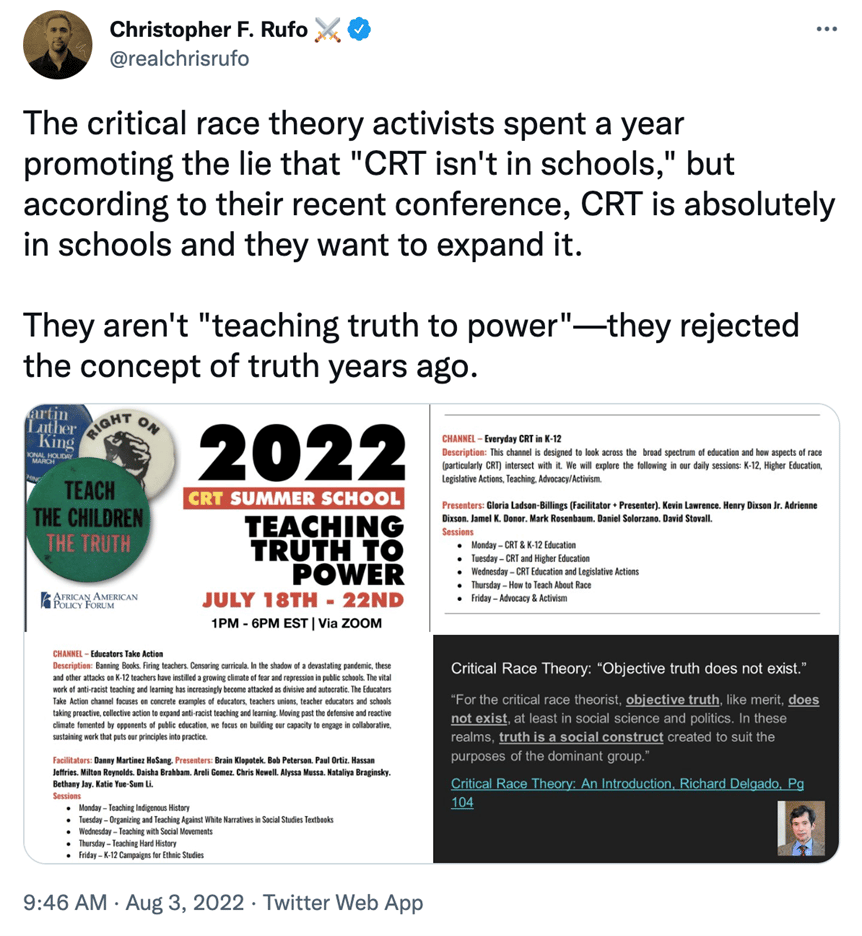
Many critics of Rufo and the attacks on CRT have indeed claimed that “CRT isn’t in schools”, but not because they’re trying to provide cover to secretly smuggle it in. As far as I can tell, most honestly believed that CRT was just a legal theory and that Rufo and Lindsay were doing exactly what Rufo said in his tweets and simply using CRT as a catch-all for “scary race education materials”. That’s why they often said some version of “it’s not in schools but it should be” or “it’s good that it’s taught at the college level but it’s too advanced for K-12”. Others meant that CRT was impacting how teachers think about their approach to teaching, but wasn’t explicitly taught as part of the curriculum. I’ve seen zero evidence – and as far as I’m aware there has been no evidence presented by anyone – that any were knowingly obscuring the role of CRT in education.
I was very lucky to be in an education program that taught about CRT during the start of the moral panic, and I could see the value of these arguments for addressing problems in education. I encouraged other supporters to argue that CRT is and should be impacting how we teach at every level and across every field of study. Unfortunately, the narrative that solidified for many was one of denial that was then debunked with tweets like this, which does in fact show a CRT in education event… albeit an event that appears aimed at combatting the CRT moral panic Rufo has driven.
The bottom right quadrant of Rufo’s moral panic puzzle is the quote from Richard Delgado, undeniably a Critical Race Theorist, expressing fairly radical skepticism about the existence of objective truth “at least in social science and politics”. Contrary to how it’s been painted by Rufo and especially Lindsay, skepticism about objective truth is not a bad thing, or particularly uncommon, especially amongst experts in many fields. People express a wide range of doubts about our ability to access “objective” truths, especially about complex and difficult to observe events like what really drives social patterns. Epistemologists throughout history have sought out viable alternatives, using terms like constructivism and pragmatism, producing ideas like “social construct” and “all models are false, some models are useful”.
Furthermore, Delgado is not the only CRT theorist, and there is open debate about theories of knowledge amongst critical theorists. Here, though, Rufo is using the quote to prove that all CRT activists do not value the concept of truth, which is why it’s so easy for them to lie and cover up their use of CRT to indoctrinate children.
Notice that it took about 500 words to thoroughly “debunk” that single Rufo tweet, which is twice as good as the theoretical average of 1,000 words per picture, but still highlights why trying to debunk this content is asymmetric warfare, and why a 2,000 word count is barely enough to get started.
How then do we calibrate our skepticism so we can decide which concerns are legitimate, and whether someone is raising a concern in good faith? Like with the problem of generalism about conspiracy theories, the best we can do for moral panics is a list of red flags, like the one Michael Hobbes has compiled, that should increase our doubt while we do our best to gather enough information to assess the details of the claims. When assessing whether someone is arguing against CRT in good faith, I do my best to see whether they’re acknowledging the legitimate responses to their criticisms and providing substantive counterarguments. It’s a red flag when someone claims to have substantial knowledge on an issue but continues to nod along to easily debunked lines of attack.
Folks like Rufo and Lindsay are easy cases for setting a baseline. It should be clear to anyone who reads their twitter feeds (at least prior to Lindsay’s recent permanent ban from Twitter) that there has been a deliberate partisan strategy to generate a moral panic around the concept of CRT, and to conflate many ordinary liberal perspectives with the topic. Similarly, it should be clear that Lindsay and others have further expanded the CRT moral panic into a more concerning “ok, groomer” queer theory moral panic, wherein even normal sex education classes are being deemed as unacceptable. Recognising these wedge strategies, as we did with intelligent design and ‘teach the controversy’ campaigns, is essential to confronting conservative activism presented as anti-woke rhetoric. Unfortunately, Shermer and other members of the US skeptical community have proven highly susceptible to these tactics.
For what it’s worth, I believe that CRT-style language can be used in a variety of harmful ways. All impactful theories carry a risk of misuse, as skeptics of quantum woo can attest. In particular, CRT-based approaches to counteracting existing power dynamics rely too much on identity-based deference politics, and so make it difficult to address when there are other issues.
I worry, in particular, about the spread of CRT-adjacent language about “alternative ways of knowing” into conspiracism and pseudoscience ecosystems. I’ve recently been writing on the Better Way antivaxxer conference, where I noticed heavy messaging around the switch from “alternative medicine” to “indigenous medicine”. I’m worried that “wokeness” will make some percentage of well-meaning social justice activists more susceptible to harmful pitches like this.
Unfortunately, anti-woke sentiments don’t appear to inoculate one against naturalism fallacies and antivaxxer conspiracism, since the conference was headlined by Bret Weinstein and Maajid Nawaz. Shermer recently interviewed Weinstein and his partner Heather Heying about their new book, but neglected to challenge them on their Covid antivaxxer conspiracism.
The Mainstreaming of a Moral Panic
Consider the question in Shermer’s original tweet. “Why won’t CRTists defend the theory?”. Taken literally, the question seems absurd. Critical Race Theory may be the most over-litigated culture war flashpoint of the past two years. Proponents of CRT have written countless explainers and defenses of CRT. I’ve personally defended it in multiple formats, and continue to teach it as part of my intro to education course. So, it’s clearly not the case that CRT advocates won’t defend the theory.
Perhaps Shermer was instead asking why CRT advocates wouldn’t agree to write a defense in his magazine. There are, of course, plenty of good reasons to not write for any given publication. CRT advocates might simply feel that enough defenses already exist, and that the widespread vilification of the topic by partisan activists like Rufo and Lindsay has made it pointless to engage further on the subject.
Or, they may have done some research and concluded, rightly in my opinion, that Shermer and his Skeptic Magazine have themselves contributed to the mainstreaming of a moral panic around CRT and “wokeness” more generally, through their uncritical promotion of the “conceptual penis” and “grievance studies” hoax papers, as well as Lindsay and Pluckrose’s Cynical Theories, which garnered substantial criticism that was then dismissed as nitpicking by the authors. Indeed, as I’ve highlighted already, the latter book was Shermer’s go-to source for what he described as a “mostly neutral” article on the history and consequences of CRT.
While Rufo has received the lion’s share of credit for inciting the CRT moral panic, Lindsay et al’s anti-woke activism served as the social and ideological springboard for the CRT moral panic, because it gave the impression that the movement grew out of concerns expressed by self-identifying heterodox liberals. Shermer even personally promoted Lindsay and Boghossian’s grievance studies appearance on Joe Rogan, an episode full of easily debunked misinformation.
Given these facts, CRT activists might reasonably conclude that it would be harmful to lend credibility to an outlet that could use it to offset further unsupported attacks. That was certainly my largest concern in deciding whether to write this piece, which was originally commissioned by Skeptic Magazine in response to my conversation with Shermer. Ultimately, I lean towards engagement, even when the chance of persuasion is likely to be low, but we don’t have remotely enough evidence to decide on the best approach to engaging with individuals and organisations that appear caught up in a moral panic.
I believe the original question was actually something of a dog whistle, aimed largely at other critics of wokeness. It served to signal that CRT advocates can’t defend the theory, and that they are too ideologically captured to admit defeat, so they instead avoid debate entirely. Douglas Murray made this accusation explicitly in his recent interview on Shermer’s podcast, around 40 minutes in. He claims it is a major red flag that CRT advocates like Kendi and DiAngelo are unwilling to engage in public debate. In the interview both men credulously repeat one of Rufo and Lindsay’s most absurd accusations: that the woke are too fragile and fanatical to risk open debate.
I don’t consider it a red flag to refuse to debate, since there is good reason to question the efficacy of such debates. However, if you do consider it such a warning sign, it’s disingenuous not to highlight that Rufo and Lindsay also routinely deride and avoid debate, to the extent of actively blocking people who attempt to engage them in good faith. Lindsay and Boghossian have claimed that social justice advocates are such “uniformly such dreadful conversationalists” that it’s pointless to engage with them, beyond learning how to counter their tactics. How could such well-poisoning be worthy of praise when it’s coming from the architects of the CRT moral panic, yet serve as a red flag when assessing CRT advocates? I think the most plausible answer is the existence of an ‘anti-woke’ in-group bias.
Shermer’s interview with Murray highlights why CRT advocates are rightly skeptical of engagement. The interview reveals the lack of serious engagement from anti-woke CRT critics, even when CRT is construed in the broad sense of “anti-racism”. Shermer and Murray treat Kendi and DiAngelo like they’re interchangeable, when they have widely different approaches. Kendi is primarily a strict-consequentialists about race, arguing that we should focus on addressing unjust outcomes and not get caught up debating intent. Conversely, DiAngelo fits more in the psychoanalysis tradition, seeking to expose psychological features that undercut racial progress. Both approaches have their strengths and weaknesses, but Murray and Shermer struggle to identify or recognise those differences, and instead fall back on complaining about how much money CRT advocates are making. Once again, there’s no consistency in their criticism, since a ‘follow the money’ critique would also involve acknowledging how Lindsay’s anti-woke business was funded and is managed by Michael O’Fallon, a Christian nationalist anti-globalist conspiracy theorist.
During their exchange over CRT, Murray and Shermer lob a series of weak objections that very clearly derive from Rufo and Lindsay’s work. One straightforward example is their claim that CRT reduces everything down to race. A key concept in CRT is intersectionality, the theory that our outcomes in life are impacted in complex ways by the overlaps between the various aspects of our identity, such as gender, class, religious affiliation, etc. If CRT truly reduced everything down to race, intersectionality would be a pointless concept. It would also contradict another common complaint, that CRT and other woke approaches set up an ‘oppression Olympics’, where the person with the most intersecting identities wins at being the most oppressed. If everything comes down to race, why would any of the other features matter? A more accurate summary of the CRT perspective is that race has had a significant and lasting impact on our society in a way that filters down into many parts of our lives, sometimes in ways that are difficult to recognise and study.
Another thoroughly debunked claim is that CRT can’t explain why certain non-white racial groups appear to be more successful than white people in a supposedly white supremacist society. This ignores significant work by Mari Matsuda and others on issues like the model minority myth, and the diverse challenges that are obscured by using such a broad category as “Asian”. Maybe Shermer and Murray don’t find those arguments compelling, but if so they ought to at least acknowledge that they exist and address the evidence supporting them. The same goes for their parroting of Thomas Sowell’s argument that black culture, not systemic racism, is causing the persistence of racial inequality. It’s disingenuous and misleading to present these ideas like they’re uncontested in the public sphere.
Renewing Skepticism Against Anti-Woke Moral Panics
The CRT moral panic has exposed how anti-woke tribalism can make one more receptive to appropriately packaged moral panic conspiracism. I’ve referenced several members of the ‘Intellectual Dark Web’ that have slid from broad skepticism about “mainstream media” and “liberal hegemony” into antivaxxer sentiment, anti-globalist conspiracism, and anti-trans conspiracism (it’s a topic I’ve covered on my podcast, including in this episode). Shermer seems, at times, to recognise the danger of Rufo and Lindsay’s slide into extremism, especially when it leads to censorship and other illiberal actions, but he and others fail to see that Murray’s “war on the west” conservatism is similarly undermined by boilerplate anti-wokeness and great replacement conspiracism. Murray has a nicer patter, and is better than Rufo and Lindsay at keeping his more extreme positions less directly stated, but his ideas and the world they would lead to are no less illiberal or “extreme”.
In his interview with Shermer, Murray insinuates that “they” are trying to make it unacceptable to praise Churchill or Jefferson, and by extension any of the good things they fought for. He leaves the scary open question as to what the nefarious end goal is for such a project. On August 6th, 2021, Murray went on Tucker Carlson’s Fox News show, where they both praised Orban’s repressive regime for its handling of immigration and speculated about a “sinister” plan to legitimise and enact regime change against any conservative government. In a December of 2020 article for The Spectator, Murray argued that China must pay Covid reparations, and engaged in what could most charitably be called conspiracism hypothesising or cheap talk skepticism about the origin of Covid as a bioweapon released to damage the US’ economy and undermine Donald Trump’s re-election bid:
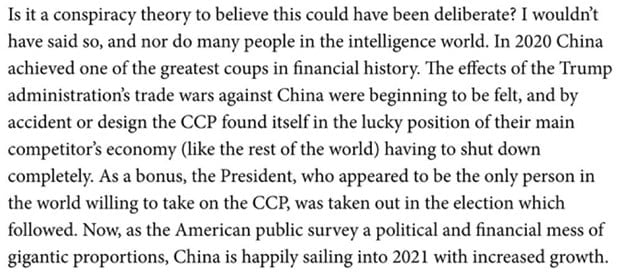
In a more recent article for The Spectator, Murray again engaged in cheap talk skepticism about covid as a bioweapon, and signaled that he was ready to jump in on monkeypox conspiracism if that gets big enough:
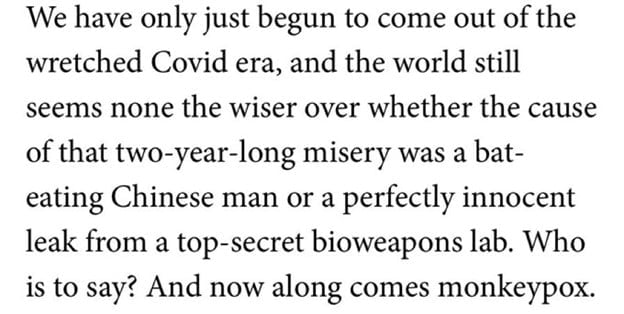
These are the kind of conspiracism and double standards that one would expect skeptics to recognise, but the anti-woke ideology seems to lead to uneven levels of charity.
Unfortunately, Rufo and Lindsay’s antics make it easy for folks like Shermer and Murray to appear moderate by comparison, while having a polite conversation where Murray declares “this is a cultural revolution” and that the people who defend and praise Mao are winning. Rufo and Lindsay may have significant influence in conservative politics, but the CRT moral panic has proven so wildly successful because self-identifying moderates laid the foundation for it and promoted it long after it was explicitly admitted as an orchestrated panic. Rufo openly tweeted his strategy in March of 2021, and Shermer was still promoting an anti-woke moral panic chart from Boghossian and Michael Shellenberger in July of 2021. I’ve written on the chart and how it shades into the same depopulation conspiracism that Lindsay started promoting when he joined up with O’Fallon.
It is possible for anti-woke folks to learn from the CRT moral panic. There’s no need to follow Lindsay and others as they move on to the “ok, groomer” queer theory moral panic. However, listening to Shermer’s recent interview with Helen Joyce, where she promotes anti-transhumanist conspiracism and claims that children are being ‘groomed into trans identities’, I’m concerned it will be difficult for some to avoid endorsing every anti-woke panic that comes along.
I sincerely believe that “wokeness” is nowhere near the top of any reasonable list of existential threats. If anything, toxic “wokeness” can be seen as an over-reaction to feeling powerless in the face of real existential threats like climate change, the rise of overt Christian Nationalism, and the GOP’s accompanying spiral into violent conspiracism.
These problems can’t be solved by attacking CRT as a religion or a communist plot to destroy “the West”. They may not be solvable at all, but if they are, it’s going to require more robust pushback against both the extremists and the “centrists” pushing these anti-woke moral panics.


